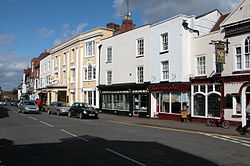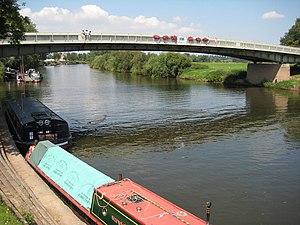Upton-upon-Severn: Difference between revisions
No edit summary |
m clean up, typos fixed: Low lying → Low-lying |
||
| Line 15: | Line 15: | ||
|constituency=West Worcestershire | |constituency=West Worcestershire | ||
}} | }} | ||
'''Upton-upon-Severn''' is a small town in [[Worcestershire]], standing on the banks of the [[River Severn]], five miles from [[Great Malvern]]. [[Crossings over the River Severn|The bridge]] at Upton is the only one across the River Severn between [[Worcester]] and [[Tewkesbury]]. The present bridge was built in 1940. <ref>[http://www.upton.uk.net/history/bridge/thebridgeatupton.pdf The Bridge at Upton]</ref> | '''Upton-upon-Severn''' is a small town in [[Worcestershire]], standing on the banks of the [[River Severn]], five miles from [[Great Malvern]]. [[Crossings over the River Severn|The bridge]] at Upton is the only one across the River Severn between [[Worcester]] and [[Tewkesbury]]. The present bridge was built in 1940.<ref>[http://www.upton.uk.net/history/bridge/thebridgeatupton.pdf The Bridge at Upton]</ref> | ||
Upton was recorded in 897. Oliver Cromwell's soldiers crossed the Severn here before the Battle of Worcester in the Civil War. The town has a distinctive tower and copper-clad cupola known locally as the ''Pepperpot'' and the only surviving remnant of a former church.<ref>[http://www.upton.uk.net/history/bridge/thebridgeatupton.pdf History of the Old Church] - Upton.uk.net</ref> | Upton was recorded in 897. Oliver Cromwell's soldiers crossed the Severn here before the Battle of Worcester in the Civil War. The town has a distinctive tower and copper-clad cupola known locally as the ''Pepperpot'' and the only surviving remnant of a former church.<ref>[http://www.upton.uk.net/history/bridge/thebridgeatupton.pdf History of the Old Church] - Upton.uk.net</ref> | ||
| Line 21: | Line 21: | ||
==The town== | ==The town== | ||
[[File:Upton-upon-Severn bridge 929084.jpg|left||thumb|The bridge at Upton-upon-Severn]] | [[File:Upton-upon-Severn bridge 929084.jpg|left||thumb|The bridge at Upton-upon-Severn]] | ||
Low lying areas of Upton suffered serious flooding in 2000. In the 2007 United Kingdom floods, levels exceeded those in 2000, and the town was inaccessible by road.<ref>[http://www.upton.uk.net/archives/floods/jul07/0index.html July 2007 Floods] - Upton.uk.net</ref> The town has been dubbed 'Upton under Severn'. However it should be borne in mind that the overall proportion of properties that were flooded remains low - the large majority of properties in Upton were not flooded. | Low-lying areas of Upton suffered serious flooding in 2000. In the 2007 United Kingdom floods, levels exceeded those in 2000, and the town was inaccessible by road.<ref>[http://www.upton.uk.net/archives/floods/jul07/0index.html July 2007 Floods] - Upton.uk.net</ref> The town has been dubbed 'Upton under Severn'. However it should be borne in mind that the overall proportion of properties that were flooded remains low - the large majority of properties in Upton were not flooded. | ||
The town has three major music festivals, with the spring folk festival, and the summer jazz and blues festivals.<ref>[http://uptonbluesfestival.org.uk/ Upton Blues Festival]</ref> | The town has three major music festivals, with the spring folk festival, and the summer jazz and blues festivals.<ref>[http://uptonbluesfestival.org.uk/ Upton Blues Festival]</ref> | ||
Latest revision as of 16:38, 29 January 2016
| Upton-upon-Severn | |
| Worcestershire | |
|---|---|
 High Street | |
| Location | |
| Grid reference: | SO852405 |
| Location: | 52°3’47"N, 2°12’54"W |
| Data | |
| Population: | 2,859 (2001) |
| Post town: | Worcester |
| Postcode: | WR8 |
| Dialling code: | 01684 |
| Local Government | |
| Council: | Malvern Hills |
| Parliamentary constituency: |
West Worcestershire |
Upton-upon-Severn is a small town in Worcestershire, standing on the banks of the River Severn, five miles from Great Malvern. The bridge at Upton is the only one across the River Severn between Worcester and Tewkesbury. The present bridge was built in 1940.[1]
Upton was recorded in 897. Oliver Cromwell's soldiers crossed the Severn here before the Battle of Worcester in the Civil War. The town has a distinctive tower and copper-clad cupola known locally as the Pepperpot and the only surviving remnant of a former church.[2]
The town

Low-lying areas of Upton suffered serious flooding in 2000. In the 2007 United Kingdom floods, levels exceeded those in 2000, and the town was inaccessible by road.[3] The town has been dubbed 'Upton under Severn'. However it should be borne in mind that the overall proportion of properties that were flooded remains low - the large majority of properties in Upton were not flooded.
The town has three major music festivals, with the spring folk festival, and the summer jazz and blues festivals.[4]
The White Lion Hotel is a 16th Century Coaching Inn, where parts of the building date back to 1510. The building has undergone many transformations over the centuries and is easily found on the high street due to its distinctive portico, adorned with its very own lion. Reputed to have played a part in the Civil War, where soldiers from both sides are alleged to have enjoyed the hospitality of this popular local hostelry prior to the Battle of Worcester. Guests of the hotel can stay in rooms referred to in books VII and VIII of Henry Fielding's classic 1749 novel "Tom Jones" in which he refers to the hotel as "A house of exceeding good repute";[5] these rooms retain many of their original features.
Upton on Severn Sports Field is the home of Upton on Severn Rugby Club, as well as being used for Welland Junior Swifts matches and other community functions.
Outside links
- Upton upon Severn Rugby Club
- Upton upon Severn Community Site
- Upton upon Severn website
- 2000 floods
- 1881 census data
- Mercia Inshore Search and Rescue
- Festivals===
References
- ↑ The Bridge at Upton
- ↑ History of the Old Church - Upton.uk.net
- ↑ July 2007 Floods - Upton.uk.net
- ↑ Upton Blues Festival
- ↑ Fielding, Henry; Tom Jones, 1861
- 'Parishes: Upton upon Severn', A History of the County of Worcester: volume 4 (1924), pp. 212–217. [1] Date accessed: 14 July 2009